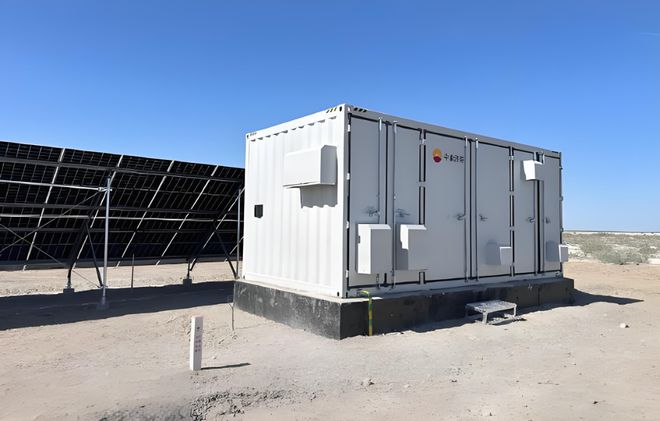There’s a saying that goes: “You can rely on external power, but I’ll be your strong backup.” In the energy industry, this phrase aptly describes the relationship between renewable energy sources like wind and solar power and energy storage solutions. This promise symbolizes the role of energy storage in supporting wind and solar power. In recent years, China's energy storage industry, particularly new energy storage technologies, has witnessed rapid growth. In 2023, the newly added capacity of new energy storage exceeded 45 GWh, tripling the installed capacity of 2022. With such a development trend, the application scenarios for new energy storage have expanded significantly. Apart from supporting wind and solar power, energy storage is now entering a new frontier—oil fields.

Recently, China National Petroleum Corporation (CNPC) conducted trials of a self-developed vanadium redox flow battery at the Qinghai Oilfield. CNPC announced that the vanadium flow battery, developed by its Engineering Materials Research Institute, has been successfully deployed. The battery was tested at the Huatugou Production Base in Qinghai Oilfield, showcasing off-grid applications under extreme environmental conditions in a “solar-storage-pumping” system.
At this point, you might wonder: Is energy storage really making its way into oil fields? Yes, it is. With the ongoing push towards the dual-carbon targets, high-energy-consuming oil and gas enterprises are now prioritizing green transformation. Oil and gas exploration remain crucial, making emission reduction in this sector a key focus. Initially, the expansion of renewable energy installations like solar panels and wind turbines was the first step, providing green power for oil extraction. However, there’s a challenge: renewable energy is intermittent and weather-dependent. This is where energy storage comes into play.
Since the start of the 14th Five-Year Plan, new energy storage has been included in the national priority development agenda. The vanadium redox flow battery featured in this report boasts several advantages, such as high capacity, long-duration storage, high safety, long cycle life, and independent scalability of power and capacity. These attributes make it an attractive option for oil and gas companies seeking to explore innovative solutions.
The R&D team at CNPC's Engineering Materials Research Institute embarked on developing different prototypes of vanadium flow batteries to address specific needs. Despite the unique advantages of vanadium flow batteries, challenges like low electrode activity and electrolyte instability persist. Hence, a simple "copy-paste" approach isn’t viable. CNPC designed and integrated various models of vanadium flow battery prototypes, alongside both grid-connected and off-grid solar-storage demonstration stations for multi-scenario testing. In mid-October, at the Qinghai Oilfield, the self-developed vanadium redox flow battery successfully passed stringent tests, including high altitude, extreme cold, off-grid operation, weak signal, and the need for 24/7 continuous power supply. The battery’s performance in green power supply and zero-carbon oil extraction was highly praised.
This achievement marks a significant milestone for energy storage, especially for new energy storage technologies, paving the way for new opportunities and opening up fresh markets.
A New Market: Oil Fields!
As previously mentioned, green transformation in the oil and gas sector is inevitable, and projects involving renewable energy are becoming more common. For example, in Daqing Oilfield, multiple wind turbines and tens of thousands of solar panels are generating green power; in May this year, a 1.3 GW solar power project broke ground at the Tarim Oilfield; and in September, a 500 MW wind-solar hybrid project commenced at the Changqing Oilfield. By July, the Zhongyuan Oilfield had an installed solar power capacity of 70 MW, generating over 80 million kWh annually. Green electricity is now abundant, but maintaining a stable supply is the next challenge, which is where energy storage systems come in.
Take CNPC for instance: In 2022, the Yumen Oilfield installed a 200 MW solar power project paired with a 40 MW/80 MWh energy storage system, utilizing lithium iron phosphate batteries. In 2023, the largest single solar power project in terms of capacity at the Tarim Oilfield was successfully connected to the grid, equipped with a 125 MW/MWh large-scale energy storage station, comprising 152 lithium iron phosphate battery containers that can discharge for four hours when fully charged.
Looking at CNPC’s mining areas, many are located in deserts, gobi, and barren lands, where renewable energy resources are plentiful but conditions are harsh. This increases the demand for robust energy storage solutions. While conventional lithium batteries struggle in such environments, flow batteries, including the vanadium redox flow battery, have shown superior performance in long-duration storage and harsh conditions.
In July, CNPC completed the commissioning of its first zinc-bromine flow battery system at the Mahudong 078 Well in Xinjiang Oilfield. The system, featuring a “solar + storage” design, can provide 4-24 hours of storage and operate at temperatures as low as -25°C. Earlier in May, CNPC’s first vanadium redox flow battery demonstration project was connected to the grid at the Daqing Oilfield. The recent success at the Qinghai Oilfield further validates the role of new energy storage solutions in the oil field market.
In summary, energy storage, particularly new storage technologies, is not only making its way into oil fields but is being effectively utilized. This trend is set to continue, with further expansion and exploration expected in the future.




